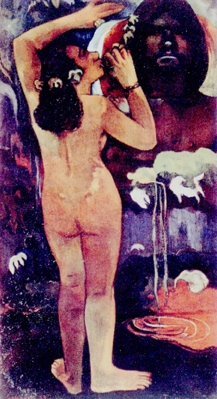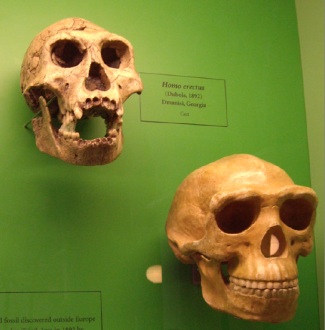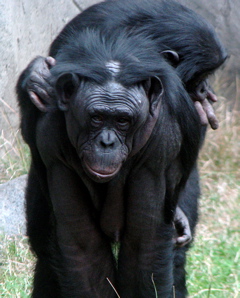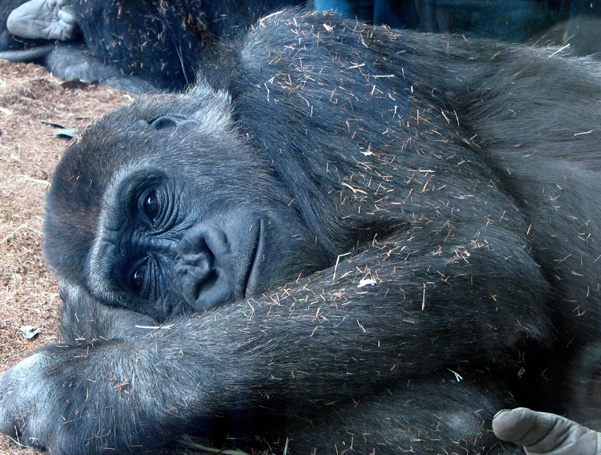
The Bonobo chimpanzee, a mother carrying her child.
"violence appears much less common among bonobos than among chimpanzees."
p. 101.
We cannot "ignore how difficult gene-gene and gene-environment interactions make it for selection to operate on just one attribute of an organism."
p. 94.
Human descent accounts for the genetic variation among populations.
Some genes on chromosomes are adaptive or maladaptive; all are partners of ecology.
Inheritable information is limited, prone to errors, & runaway feedback.
All humans are vocal, social animals with a long childhood.
Diversity abounds: differences are manifest in variety of food, sects of faith, dialects of language, & customs.


- The Agricultural revolution ... launched our species because it separated humans from being solely at the mercy of natural changes.
- "cultural stickiness" emerged as a means of solidarity among ever larger and more varied groups.
- The variable pace of "different rates of change" opened populations to a wider array of behavioral adjustments to altered conditions.
"a theory of mind....that capacity lies behind all important aspects of human social behavior...."
"One person knows that another is a thinking being–"
p. 97.

The capacity to sense in another the same mental activity we enjoy in yourself.
"Imagination …is a major driver of cultural evolution."
There are three types of imagination:
- ability to mentally picture the consequences of future actions
- power to fantasize–"imagine a fantasy world where the laws of nature no longer apply."
- "leap of imagination" is the capacity to envision connections between the known and new conditions
- Sir Charles Lyell, uniformitarianism in geology; what happens now happened then in the geological past.
- "natural selection could be the mechanism responsible for the great diversity of life."
p. 98.
"Imagination and an active theory of mind are central to the processes of cultural evolution as well as to engagement in the most complex human enterprises."
p. 98.
The roots of warfare
"human aggression can take quite different forms."
p. 99.
Behavior among Apes
- greeting protocols
- rivalry for dominance
- nesting
- mates
- food
- infanticide
- bullying
- Territoriality -- "securing space" -- "foraging territory"
p. 101
"Chimpanzees hold territories as groups, and they do so very aggressively."
"violent inter clan battles. . . on occasion, torn apart and eaten."
p. 101.
…the belief that warfare is innate also traces to the observation that some other social animals ...engage in intergroup violence."
p. 101.
"careful examination of prehistoric human remains shows lots of depressed skull fractures, bones cleaned for cannibal feasts, vertebrae with embedded projectile points, and traces of fortifications that indicate that hunters and gatherers and early farmers were sometimes peace-loving but often not."
"resource shortages and population pressures were involved in the generation of conflict."
"intergroup violence ...evolved"
changed over time with circumstances and input
...the available habitat had very recently been been greatly constricted."
p. 102.
Norms – Any norm refers to behaviors common to a social group or sub-group, often sanctioned by a shared culture.
Three means of passing information because of language and tools
"Among human beings, genes can pass only unidirectional [in one direction] from one generation to the next via reproduction (vertically). But ideas.., now regularly pass between individuals distant from one another in space and time. . ."
- vertically - from parental generations to siblings
- obliquely - from non-parents (Buddha, Plato, Jesus) "to succeeding generations"
- horizontally - across members of the same generation
p. 116.
"...the basic assumption is that the spread of norms shares important characteristics with epidemic diseases. Norms spread vertically, horizontally and obliquely ...mediated by webs of contact and influence. . . . norms may wax and wane as people's ideas and beliefs change.
p. 116.
A culture often lags behind changes in he surroundings or in new behaviors adopted from other cultures.
![]()
Hominidae, the human family.
"For much of hominin evolutionary history we have been social, small-group animals, with a recognition of self and a theory of mind to match it. When biophysical environmental pressures are not constraining the direction of evolution, human groups seem to have a tendency to differentiate themselves from other groups–...."
p. 117.
culture | culture hearths | cultural landscapes | cultural resistance


